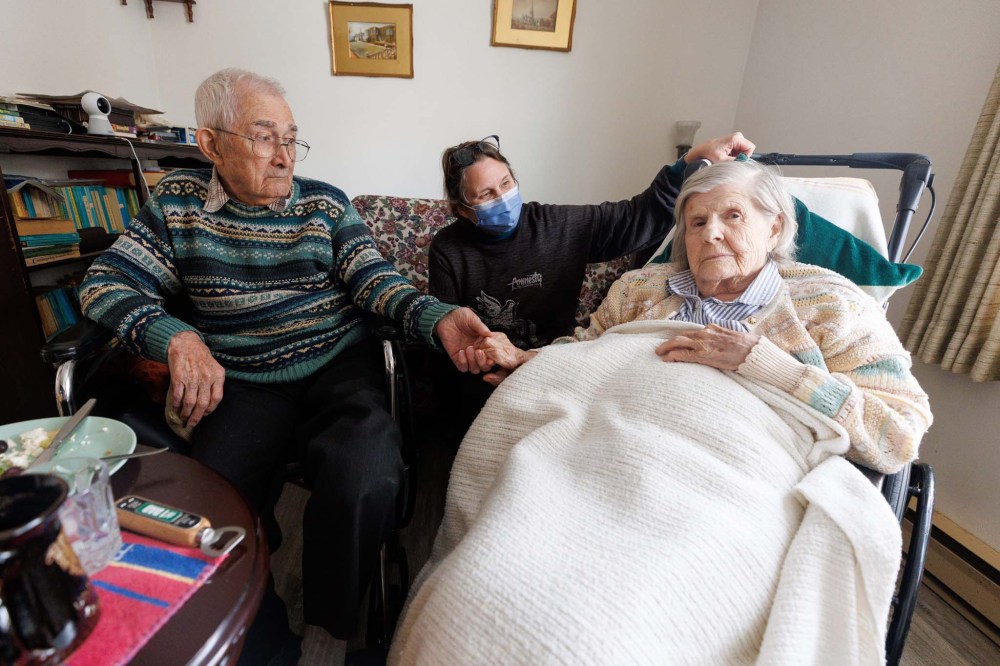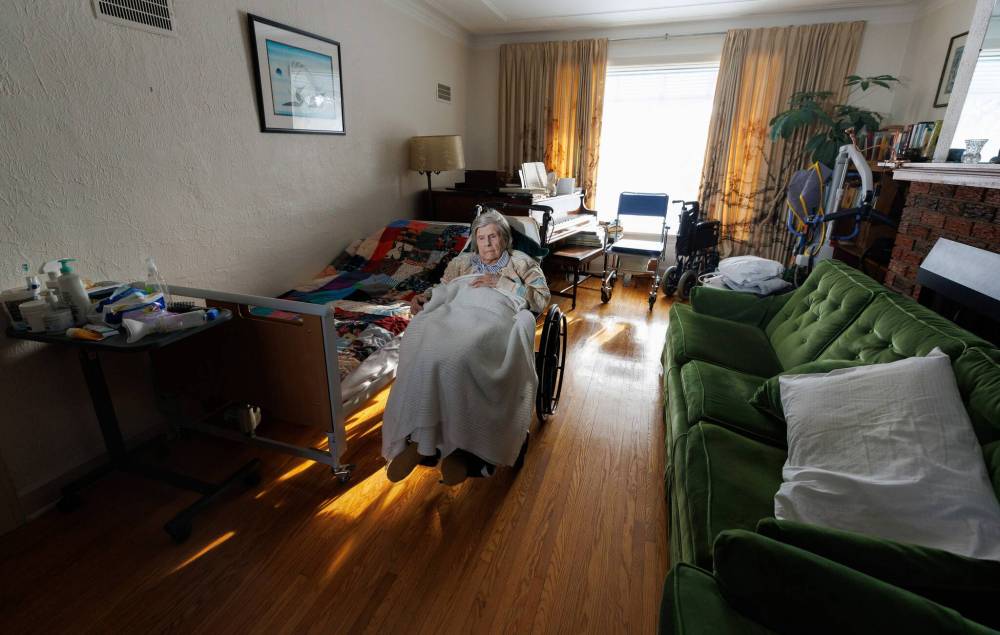The care-home crisis Delivery of service struggles to meet the needs of province’s vulnerable aging population
Read this article for free:
or
Already have an account? Log in here »
To continue reading, please subscribe:
Monthly Digital Subscription
$0 for the first 4 weeks*
- Enjoy unlimited reading on winnipegfreepress.com
- Read the E-Edition, our digital replica newspaper
- Access News Break, our award-winning app
- Play interactive puzzles
*No charge for 4 weeks then price increases to the regular rate of $19.00 plus GST every four weeks. Offer available to new and qualified returning subscribers only. Cancel any time.
Monthly Digital Subscription
$4.75/week*
- Enjoy unlimited reading on winnipegfreepress.com
- Read the E-Edition, our digital replica newspaper
- Access News Break, our award-winning app
- Play interactive puzzles
*Billed as $19 plus GST every four weeks. Cancel any time.
To continue reading, please subscribe:
Add Free Press access to your Brandon Sun subscription for only an additional
$1 for the first 4 weeks*
*Your next subscription payment will increase by $1.00 and you will be charged $16.99 plus GST for four weeks. After four weeks, your payment will increase to $23.99 plus GST every four weeks.
Read unlimited articles for free today:
or
Already have an account? Log in here »
Hey there, time traveller!
This article was published 27/12/2024 (327 days ago), so information in it may no longer be current.
A wait time lasting nearly a year, an unsanitary care home and hefty expenses.
The Ledwich-Pogson family experienced the worst of Manitoba’s long-term care system at a time when they were most desperate.
Their experiences are not unique to many Manitobans. Despite recent government efforts to address critical shortcomings, the system continues to struggle to service the province’s most vulnerable, critics say.
Among the most pressing issues are bed shortages and lengthy wait times, differing levels of care and discrepancies in quality between public and private for-profit homes.
Jane Pogson said she’s worked with some “amazing, amazing people” among health-care workers, but overall “the system isn’t working. That shouldn’t reflect on my mom and dad.
“I’m fighting for my mom and dad.”
Pogson’s mother, Ann Ledwich, who has advanced dementia, waited nearly a year for a bed at Meadowood Manor, a non-profit faith-based care home in St. Vital.
But after she fell and broke her hip in November 2023, the family faced a difficult choice. She couldn’t recover at the hospital where she had surgery because there was a more pressing need for the bed. While still holding out for Meadowood, they were offered a spot at Extendicare Tuxedo Villa, a private, for-profit home.
The family decided it was safer to move Ann where they have a regular visiting occupational therapist rather than return her home.
Their opinion changed shortly after Ann arrived. Staff seemed unaware she was at risk of falling, her bed lacked basic safety features and there was little room for her to eat in the dining room. Pogson also noticed mice scurrying in the halls.
“I reported it to the nurse at the desk and she just laughed. She said, ‘Oh yeah, you’ll get used to them. They’ll become your friends,’” Pogson told the Free Press.
Jane Pogson (centre) with her parents Rodney and Ann Ledwich in their home on Assiniboine Avenue. Pogson and her family’s decision to abandon the personal care-home route and lean heavily into private home care is cemented in negative experiences all too familiar for many Manitobans.
Fed up, Pogson took Ann home where she remains with her husband, Rodney Ledwich. However, the private home care costs about $400,000 annually, since a wheelchair-bound Ann, 92, needs around-the-clock care while Rodney, 91, requires about 11 hours of care daily.
Today, Pogson counts herself among the fortunate trying to find appropriate long-term care. But she knows it comes at a cost few can afford.
“For starters, my parents, thank gosh, can afford to stay in their home at cost of upwards of almost half a million a year,” Pogson said.
Pogson and her family’s decision to abandon the personal care-home route and lean heavily into private home care is cemented in negative experiences all too familiar for many Manitobans.
Among the more pressing is wait times for a bed — of which there are 9,597 across 124 licenced personal care homes in Manitoba. Anecdotally, waits can last up to a year as in the Pogson case, but it’s difficult to determine firm numbers across the province.
As of 2019, the provincial government stopped publishing median wait times for PCH admissions. Shared Health officials told the Free Press that the median wait time for residents 75 and older is 6.6 weeks.
But a much more complex picture emerges when speaking to officials from the five regional health authorities.
As of late November, the supplied figures for wait times were an average of 167.5 days (roughly 24 weeks) for the Northern Health Region, an average of 86 days (roughly 12 weeks) for acute and transitional care for the Interlake-Eastern RHA, and a median of 83 days (roughly 12 weeks) for Prairie Mountain Health.
The two remaining regional health authorities, Southern Health and Winnipeg, did not provide precise figures for median or average wait times.
National health-care crisis
Wait times are a persistent backdrop to what many perceive as a national health-care crisis. Manitoba’s more than $8-billion health-care system is interdependent, meaning issues at the front end, such as clogged ERs, surgery delays and doctor shortages, will have a knock-on effect on access to personal care homes.
According to the Fraser Institute, the median wait time between referral from a family doctor to treatment is at a record 30 weeks for Canadian patients — or 222 per cent longer than it was in 1993. That results in worsening of chronic and acute conditions, increased mortality, pain and suffering, and a deepening mistrust of political and health authorities.
For Pogson, quality of care is the most pressing issue. “If you deal with the grassroots stuff then maybe the wait times will reduce themselves. You have to deal with the long-term care homes first.”
Health, Seniors and Long-term Care Minister Uzoma Asagwara said in a year-end interview with the Free Press that more needs to be done on that front and that the Kinew government is stepping up efforts to address the needs of Manitoba’s aging population.
“We’re going to initiate a new personal care home build every year,” said Asagwara, who was in Lac du Bonnet on Dec. 20 to announce construction was about to start on a 95-care home.
Meanwhile, 110 of the 200-plus beds closed under the previous Conservative government have been reopened, Asagwara added, and the province is adding 70 transitional beds for people waiting in hospital for a care home bed, with 40 already up and running.
Experts in Manitoba and across Canada have long sounded alarm bells about the quality of long-term care, characterizing the degree of service as chronically underfunded and poorly integrated within the broader health-care system.
According to a 2023 article in the BMJ medical journal, Canada’s long-term care homes “experienced among the highest proportion of deaths among all COVID-19 deaths worldwide… This crisis was predicted in more than 100 reports and inquiries over the 50 years preceding the pandemic.”
Ann Ledwich in the living room of her home on Assiniboine Avenue which has become her bedroom. Ann’s daughter, Jane Pogson, is sharing
her experience after pulling her mother out of a personal care home. 
Maples Long Term Care facility was ground zero for COVID-19 in Manitoba. A 2020 outbreak infected 231 residents and staff and left 56 dead, which resulted in the privately owned facility’s license being placed under review and triggered an external review.
The subsequent report, conducted by former B.C. deputy health minister Dr. Lynn Stevenson, flagged “confusing” and “unwieldy” pandemic planning and directed 17 recommendations at care-home owner Revera, the Winnipeg Regional Health Authority, the health incident command structure and Manitoba Health.
In April 2022, Heather Stefanson’s Progressive Conservative government pledged $15 million to address the recommendations, including hiring infection control staff and quality control officers to monitor the province’s PCHs.
In July 2023, her government pledged to disband the Protection for Persons in Care Office and replace it over the next 18 to 24 months with an independent investigation office reporting directly to the legislative assembly, although that has not happened yet.
With the Stevenson Review identifying staff shortages as a key factor in the Maples outbreak, the provincial government has also been investing in hiring more health-care aides and nurses to increase paid hours of care per day for residents.
Manitoba now funds up to 3.8 hours of care, allocating $43 million this fiscal year to achieve that goal. The national standard, meanwhile, is 4.1 hours of care.
Niall Harney, a senior researcher specializing in health care and labour issues at the Canadian Centre for Policy Alternatives, said the province is moving in the right direction despite trailing the national standard.
“The workers won a really strong collective agreement that’s going to come online now which… is really going to, I think, help with attracting workers into long-term care and home care as a career.”
While Harney stressed there’s still a long way to go, he said the government’s plan to establish an independent seniors’ advocate office is another hopeful sign.
RUTH BONNEVILLE / FREE PRESS Niall Harney, of the Canadian Centre for Policy Alternatives, says recent gains by health-care staff in collective bargaining should help attract new workers.
Gladys Hrabi, CEO of the Manitoba Association of Residential and Community Care Homes (MARCHE), which represents 23 non-profit care homes in the province, said reform must go much further than the programs implemented in response to the Stevenson Review.
“So, when pandemic happened in 2020 and Maples happened, those problems, those should show the crack in the system that we have been talking about for a long time,” she said, referring to a 2019 MARCHE report emphasizing the impacts of chronic underfunding to the province’s non-profit PCHs.
“Then Stevenson funding came… but it’s just a Band-Aid in a bleeding system.”
Hrabi calls for a “reimagining of long-term care,” which, for starters, would mean a new funding model designed to address not just workforce shortages — but also aging infrastructure and overall rising operating costs in an era of heightened inflation.
It’s a wish that faces significant monetary challenges.
In his mid-year fiscal and economic update on Dec. 16, Finance Minister Adrien Sala said the province is on track to end the fiscal year $1.3 billion in the red and signalled out the $438 million in overspending by the Department of Health, Seniors and Long-Term Care.
“To put it simply, we are seeing too much money being spent in the boardroom rather than at the bedside,” Sala said.
The path to long-term care is labyrinthian and expensive.
Well before arriving at a PCH, families are faced with a multitude of questions: can their parent still live at home with assistance from a provincial home care worker? Would additional private home-care service be a better, though more costly option? Would a retirement home or assisted living, which in Manitoba will run from $3,000 to $6,000 a month, help ease the transition?
At some point, a care home, with more access to nurses, therapy and involved forms of care, is likely the only remaining option. A family can submit up to two care home choices to their regional health authority.
For cultural reasons, a religious or faith-based care home, like Holy Faith or The Saul and Claribel Simkin Centre, may be preferred. But as Ann Ledwich’s case shows, a sudden change in health may mean needing a bed right away, limiting options.
As far as her daughter is concerned, choosing a private care home is a risk people shouldn’t have to take. “We shouldn’t be trading people’s lives for profit,” she said.
“We shouldn’t be trading people’s lives for profit.”–Ann Ledwich
She’d just as soon phase out the province’s private, for profits, which operate 25 per cent of the beds in the province. So would the Canaadian Centre for Policy Alternatives.
Their views align with two thirds of Manitobans who, according to a 2020 Probe Research poll, want government or non-profits to take over at least some of the province’s private PCHs, with 40 per cent calling for the latter to be completely absorbed.
Frustrations with private, for-profit PCHs’ quality of care are fanned by unpleasant realities.
“The literature does point to that… that for-profit facilities (have) worse outcomes than non-profits,” said Genevieve Thompson, a professor in the College of Nursing at the Rady Faculty of Health Sciences. “So that’s been the consensus really for decades now.”
“Even if you jump forward to the pandemic and post-pandemic period,” she added. “The reports are saying that deaths per bed were highest in for-profit personal care homes, not just in Manitoba, but Canada.”
Malcolm Doupe, a professor at the University of Manitoba’s Max Rady College of Medicine, co-authored a 2019 article entitled Privatization of Long-term Residential Care in Canada.
The authors questioned how Manitoba’s private care homes maintain their profit margin, given that their revenue from government and residents is the same while “the costs incurred by for-profit nursing homes in this region are, on average, almost $2,200 higher per bed than non-profit facilities.”
“The literature does point to that… that for-profit facilities (have) worse outcomes than non-profits.”–Genevieve Thompson
Harney is more direct: “These corporations need to make profit for their shareholders. And the way they do that is by minimizing staffing, pushing staff to do more with less, and generally putting a squeeze on the amount of time staff have to work with residents.”
Defenders of private of long-term care, such as C2C and the Fraser Institute, argue public-private collaboration promotes “decentralization” or provincial autonomy and consumer choice in a field where demand for care far outstrips supply.
Regardless, private solutions are becoming a bigger part of the health-care conversation. More than half of Canadians (52 per cent), according to Ipsos research, say they’d like greater access to services provided by independent health entrepreneurs. In fact, Canada’s private health-care market has been growing steadily for years, accounting for 29 per cent of health dollars spent in 2023.
Hrabi’s call for a “reimagining of long-term care” suggests more government intervention, however she also wants to clear greater space for PCH residents to manage their daily lives.
She advocates for a movement towards what’s called “person-directed living” in the sector, where residents are more engaged in decisions about the little things that quickly add up: wake-ups, meal times, recreational activities.
Hrabi highlights Riverview Health Centre as a local leader on that front.
MIKAELA MACKENZIE / FREE PRESS André Hall-Grusska, an artist and Riverview resident, ‘fell in love with the place,’ and is striving to make it feel less like an institution.
Andre Hall-Grusska is a resident of Riverview’s PCH with Parkinson’s. He arrived two years ago and says he quickly “fell in love with the place.”
Riverview helped to organize an exhibition of his artwork last fall, and he’s now chairperson of the Riverview Residential Council. In this capacity, he strives to make changes to further ensure the centre feels less like an “institution.”
“This is your home. You have so much… freedom to do what you want to do.”
conrad.sweatman@freepress.mb.ca
— with files from Carol Sanders and Gabrielle Piche

Conrad Sweatman is an arts reporter and feature writer. Before joining the Free Press full-time in 2024, he worked in the U.K. and Canadian cultural sectors, freelanced for outlets including The Walrus, VICE and Prairie Fire. Read more about Conrad.
Our newsroom depends on a growing audience of readers to power our journalism. If you are not a paid reader, please consider becoming a subscriber.
Our newsroom depends on its audience of readers to power our journalism. Thank you for your support.
History
Updated on Monday, December 30, 2024 4:21 PM CST: Corrects factual error












